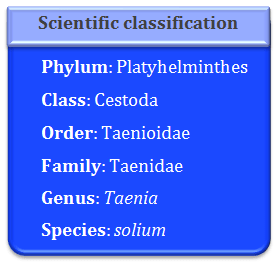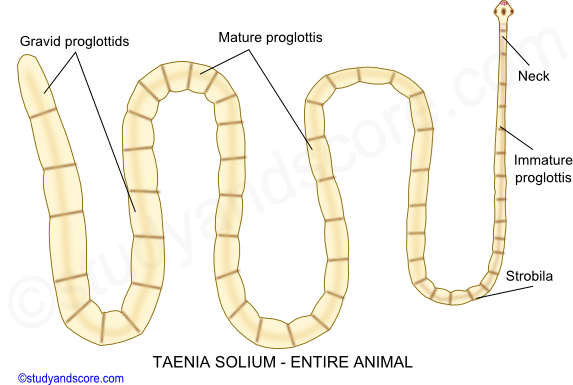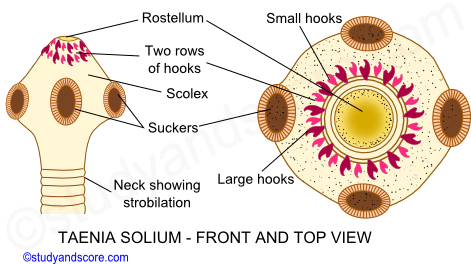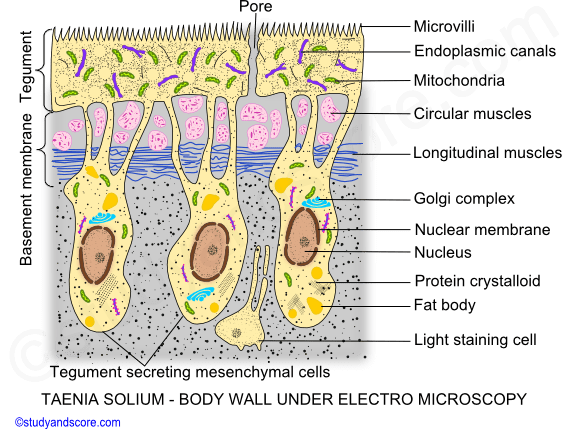
Taenia is Worldwide or cosmopolitan in distribution. It is more prevalent in poorer communities where humans live near pigs. Uncommon in Israel and other Muslim communities where pork is forbidden for religious reasons.
Taenia commonly lives in the intestine of humans who consume pork. So it is also called as pork tapeworm. This parasite completes its life cycle in two different vertebrate hosts namely man and pig. Man is considered as the definite host and pig is considered as intermediate host. Due to the infection of Taenia solium, host gets either complete or partial immunity. This phenomenon is called as premonition. Taenia saginata is the beef tape worm, which do not have hooks. The intermediate host of T. saginata is cattle.
The body of Taenia solium is elongated, dorso-ventrally compressed and ribbon like. It appears like a tape and so it is called as the tape worm. The color of the body is white to cream. The length of this animal varied between 2-4 meters. The body of the tape worm is divided into three regions namely scolex, neck and strobila.

A pear shaped, pin head sized body called as the scolex is present at the anterior end of the body. At the anterior end of the scolex, a conical and muscular structure called as rostellum is present and below this rostellum 22 to 32 hooks are arranged in two rows. These hooks are made up of chitin. The hooks in the upper row are larger and the hooks in the lower row are smaller in size. On the scolex four round and powerful suckers or acetabula are present just below the hooks. With the help of all these organs namely rostellum, suckers and hooks, this animal attaches itself to the intestinal wall of the man. Hence scolex is also known as the holdfast organ of Taenia.

The narrow and short unsegmented region behind the scolex is known as the neck. New segments are formed in this region and are pushed backwards. This process is known as strobilation. So, the neck region is the region of growth of this parasite and also known as the zone of strobilation or growth zone or zone of proliferation or budding zone.
The entire elongated part behind the neck is called as strobila. Strobila is divided into 800 to 900 segments called as proglottids. In Taenia solium the proglottids are arranged serially on after another in the chain-form and hence the name Taenia solium (solium in Greek means chain). In the strobila all the old segments are present in the posterior region and the new segments are present in the anterior region. All the proglottids are attached with one another with the help of longitudinal excretory canals and nerve cords which pass through them.
This division of the segments in Taenia is not similar to the metameric segmentation as found in the animals of the phylum Annelida. Rather the segmentation in Taenia is called as pseudometamerism.
Based on the degree of development of the reproductive organs in the proglottids, they are categorized into immature, mature and gravid proglottids.
The first 200 proglottids behind the neck are immature proglottids as the reproductive organs in them are not developed. Immature proglottids are wider in length.
The next 450 proglottids behind the immature proglottids are mature proglottids as the reproductive organs in them are well developed. They are square in shape. Each mature proglottid has a genital papilla in the middle of the lateral margin. A common genital pore is situated at the tip of the genital papilla. The genital pores are arranged irregularly and alternatively between the right and the left margins of the successive proglottids. This arrangement facilitates the exchange of gametes between two different proglottids.
About 250 proglottids in the posterior end of the parasite are called gravid proglottids. These are the oldest proglottids which are wide and rectangular in shape. The uterus in these proglottids is filled with many eggs in various stages of development.
In Taenia solium these gravid proglottids are regularly detached from the posterior end of the main parasite body. These detached proglottids are sent out through the faeces of the host. This shedding of gravid proglottids by the tape worm is termed as apolysis. This mechanism is useful to maintain the length of the body and also spreading infection.
The body wall of Taenia consists of Outer tegument and inner basement membrane. Basement membrane includes both the musculature and the packing material called parenchyma. Taenia consists of two types of muscles namely longitudinal and circular mucles.
A thick, syncytial cytoplasmic layer called as tegument covers the whole body of the tapeworm. It is derived from the tegumentary secretory cells. The tegument is connected to the tegumentary secreting cells with strands of cytoplasm called as trabeculae. Tegument is helpful in protecting the inner parts of the body. Numerous microvilli are present on the outer surface which helps in increasing the surface area of absorption of nutritive substance from the host. At some places on the tegument minute pores are present through which the predigested food is absorbed.

Circular and longitudinal muscles are present below the tegument. These muscles are called as tegumentary muscles are they are associated with the tegument. Tegument is followed by mesenchyme. In the parenchyme of the proglottid longitudinal muscles and circular muscles layers and dorsoventral muscle fibers are present. These muscles are called as parenchymal muscles as they are associated with the parenchyma.
Alimentary canal is absent in tapeworm. The spaces around the internal organs in the proglottids are filled with parenchyma tissue. So tape worms are acoelomates. The embryonic mesenchyme is differentiated into tegument forming cells, flame cells, muscles and parenchyma.
Parenchyma is syncytial network formed by branched mesenchymal cells. The spaces in the network are filled up with a fluid whose turgidity maintains the form of the body and it also acts as hydraulic skeleton. Parenchyma also helps in the transport of substances to tissue. Parenchyma acts as the packing material for internal organs.
Tapeworm lacks alimentary canal in all stages of the life cycle. The predigested food from the small intestine of the host is the chief source of nutrition for tapeworm. Soluble nutrients like glucose, amino acids, and glycerol diffuse directly through the general body surface. The surface of absorption is increased by numerous microvilli present on the outer surface of the tegument.
The respiration is anaerobic type or anoxybiotic type as there is no free oxygen available in the human intestine. The principal reserve food, glycogen is the main source of energy which undergoes glycolysis to produce carbon dioxide and fatty acids.
Nervous system of consists of two cerebral ganglia in the scolex connected together by a thick transverse nerve and a cerebral nerve ring. There is another rostellar nerve ring that has a pair of rostellar ganglia in rostellum. These two rings are interconnected by eight nerves. The suckers and rostellum are supplied by the nerve fibers from cerebral and rostellar ganglia.
From the posterior side of the brain complex, five pairs of longitudinal nerve cords arise to extend to the length of body. Out of these two lateral longitudinal nerves are best developed. The longitudinal nerve cords are connected in each proglottid by a ring connective situated below the transverse excretory canal. Sense organs are absent in tape worm but free nerve endings are abundant in the scolex and rest of the body.
The excretory system of the tapeworm consists of excretory canals and flame cells. Excretory canals include two lateral longitudinal canals and secondary canals. Flame cells are scattered throughout the parenchyma. Each flame cell is irregular in shape with granular cytoplasm and a nucleus.

- Share with your friends! -
Login to post your comment here...
- or with social Account -